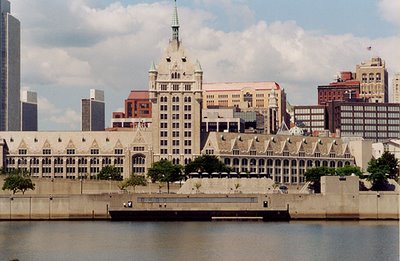Half Moon Rising

A little bit of Albany history...
By the beginning of the 20th century, Albany had become an important, versatile transportation center connecting major markets throughout the Northeast, just as the railroads were beginning to surpass riverboats as the primary mode of transportation. The Delaware & Hudson Railroad company, one of the largest in the country, responded to this boom by building one of the most elegant buildings in the State of New York for its headquarters. Overlooking the mighty Hudson on one side, and surrounding a beautiful green plaza on the other, it formed the focal point of lower State Street, with the New York State Capital building in full view at the upper end.
At the time the new building was being conceived, it was common to look to specific precedents in the architecture of the past for inspiration. Thus, Architect Marcus T. Reynolds selected the Guild Hall of the Cloth Makers in Ypres, Belgium (also known as the Cloth Hall)
 as the primary model for the new building. Begun in 1205 and completed in the 15th Century, its architectural style was early Flemish Gothic. By coincidence, the Cloth Hall at Ypres was destroyed by German artillary fire in November of 1914, shortly after work was begun on its counterpart in Albany.
as the primary model for the new building. Begun in 1205 and completed in the 15th Century, its architectural style was early Flemish Gothic. By coincidence, the Cloth Hall at Ypres was destroyed by German artillary fire in November of 1914, shortly after work was begun on its counterpart in Albany.To commemorate Henry Hudson's trip up the river in 1609, Reynolds chose a model of Hudson's ship, the "Half Moon" as the crowning ornament of the central tower of the new building. Regularly refinished in goldleaf, this landmark is the largest working weathervane in North America, measuring seven feet long and nearly ten feet high, and sails high above the Albany skyline to this day.






4 Comments:
After writing this, I realized that the tiny, but beautiful, building to the right of the D&H was the ticket office for the Hudson River Day Line, where we would purchase our riverboat tickets long, long ago. There, written in brick and mortar on the banks of the Hudson, the history of the two modes of travel and transport; one overtaking and eventually far surpassing the other.
And didn't that later become for a time the French restaurant (L'Auberge de Fougeres) where I worked college summers?
Mick Brady, I do not see your name in the 1960 year book as a junior or senior.
I am assuming you left McClosky in 1960 and found your way to Schuyler for the 1960-61 year.
Enjoyed reading your srticle. The bent pinky was all Ben's.
I did hear the word "logorrhea" for the 1st time in my life when I was standing in line waiting my turn to speak with him. That is when I learned what the word meant...and how you were to behave in "the line".
Someone ought to write a book.
Ah...but I do see the face of what I remember as a "quiet one".... Francis Joseph Brady who does indeed have the gift of gab of an Irishman.
Did our teachers miss your talent...or were you not sharing it then?
Tonia
Post a Comment
<< Home